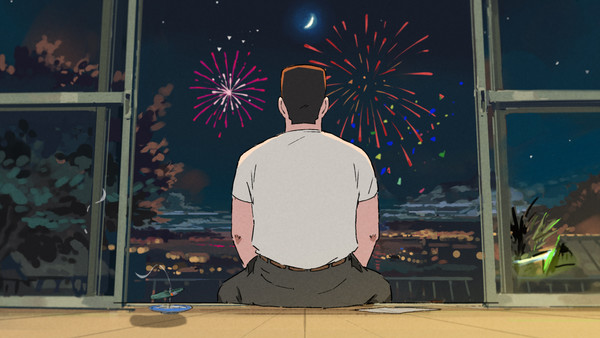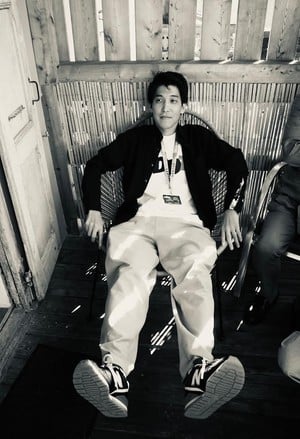ODDTAXI's Baku Kinoshita On His New Film, Housenka
by Matthieu Pinon,
Three years after ODDTAXI, Baku Kinoshita is back with a feature film, Housenka. This movie will be focused on an old yakuza, agonizing in his cell and remembering his past life while chatting with his talking flower. The director was present at the Annecy Festival for a “Work in Progress” session, where he showed preparatory documents with concept artist Michinoku-Toge and animation producer (and studio CLAP CEO) Ryoichiro Matsuo. A few moments later, he took time to answer ANN's questions about this movie planned for release in the future.
ODDTAXI is a series about links between people and opening up to others. Housenka seems to be more focused on inner thoughts, an introspective journey into the hero's mind and past.

Baku Kinoshita: In ODDTAXI, there are about twenty characters. Because I had a limited time, I could only scratch the surface of those characters. In Housenka, there are three main characters, so it allows me to go much deeper psychologically. That is what I want to do this time: more focus on characters, depicting them in higher resolution.
In ODDTAXI, a lot of scenes happen inside the taxi. In Housenka, the hero is confined in a cell. Is it important to you to get a fundamental location to develop your story?
KINOSHITA: I guess, but I don't think it's particularly unique. It's just a case of finding the right setting for that character. It's one of the first things I do when I create characters, asking myself, "Where are they?”
ODDTAXI was a TV series. It's longer (6 to 7 hours long) but also shorter (each episode is 30 minutes long) than a movie. Then you directed ODDTAXI: In the woods, a feature film that is 128 minutes long. It's another style of writing. Was it helpful to work on this feature film to create Housenka?
KINOSHITA: With the ODDTAXI movie, 80% of that was lifted from the series. The only new parts that we actually made in the movie were about 20 minutes. So, I didn't feel like I was working on a feature film. But this time, on Housenka, I really got this feeling of working on a movie.
The hero of Housenka experiences a lot of flashbacks in the 1980s, which is the end of the Showa period. Why this period, specifically?
KINOSHITA: First of all, I wanted to make a story about the ephemeral life of "good times and the decline that followed," and I also wanted to overlap that with the life of an outlaw. With that in mind, I felt that the latter period of the bubble economy in Japan was the most appropriate time for the story.
During the Work in Progress, you explained how you have been working on the house setting, especially with the colors. But what was your approach for the prison cell? It seems to be really monochromatic…
Michinoku-Toge: When you think of a prison cell, you think of Prison Break, a slum-type, ominous, dangerous feeling space. And that wasn't what the director wanted. He wanted the place to feel quiet, peaceful, and gentle. And, in the moonlight, it actually felt warm. That's what I tried to create.
And how did you manage to create it?
MICHINOKU-TOGE: I needed to use the colors to create that sense of mellowness, that positive feeling of space. And these night-time scenes, normally, would use a greenish-blue or a purplish-blue. But in the end, I found that the color that most created this feeling was a light blue that we actually used on the screen. And then, with the lighting… In real life, moonlight is not clearly visible to the naked eye, but we exaggerated the image of the beautiful moonlight. I wanted to use that light, with reflected lights as well, to make it look beautiful. That is something I tried to use in that space.
You explained that the main character is really tidy. Everything is in its right place in his home. Are you also a tidy person at work? Also, in terms of the production, is the production flow supposed to be exactly the way you want it, or are you open to suggestions that could bring some “chaos”?
KINOSHITA: The fact that the character is very tidy is quite important in the film. It's not a reflection of me so much as the screenwriter's idea.
I was asking this question because there has been a huge change in the production. Housenka was supposed to be a short film, and then it became a long feature. Why did you decide that? And how did you manage this change?
KINOSHITA: That is quite simply because I asked for a twenty-minute-long script… and the script I received was much longer! And I'm the type of person who takes my time with direction, so it ended up as a feature-length movie! (laughing).
Can you tell me more about the way you work with Kazuya Konomoto? How did you meet him?
KINOSHITA: ODDTAXI was the first time that I worked with Kazuya Konomoto, so Housenka is only our second collaboration. On ODDTAXI, I didn't find him myself; it was the producer who needed someone who could write a mystery who found and introduced Mr. Konomoto to me, and he put us together. On ODDTAXI and Housenka, we have worked the same way. First, I draw characters. Then I give my sketches to Mr. Konomoto, and he develops the story after them.

You're in the drawing phase, and the animation will follow very soon. Do you consider the designs and settings to ease the work of animators? Or are you creating just the way you want, and they will have to adapt, even if it's really hard?
KINOSHITA: When you talk about making their work easier, there are two elements. The first one is about the work environment ; the other is in terms of instruction, how much freedom they get. In the case of Housenka, I don't set hours for the animators for the working time. And on the second element, I give quite detailed instructions, so there is not a lot of freedom.
During the Work in Progress, you talked about settings and props from the end of the 1980s, but you didn't talk about fashion. How did you work on that part?
KINOSHITA: I created the character designs, so that's me who was in charge. 1980s fashion is quite outdated. I wasn't around then, so I did a lot of research through photos and old movies to use them as references.
Could you have asked your parents to show you old photos?
MICHINOKU-TOGE: I did ask my parents, but they didn't have any photos. But in terms of the set, the house where I grew up was built in the middle-to-late eighties, so I was aware of that kind of environment. And then, I also looked for pictures on the Internet.
KINOSHITA: For the backgrounds, because the eighties is having a kind of revival in Japan, there are so many people who go around 1980s buildings, take photos, and post them on social media. So I followed a lot of those people, and that was useful for getting an idea, a feeling for the buildings.
ODDTAXI has been watched outside Japan and all over the world, including in the U.S. Did you have that in mind when creating Housenka? Have you been thinking about an international audience during the production?
KINOSHITA: I don't think that I'm making Housenka for the fans of ODDTAXI (laughing). I think it's important that it feels rooted in Japan, in the place where I was born.

Mr. Matsuo, you had been working with Masao Maruyama. And Maruyama always wants to produce movies that open new ways for Japanese animation, to explore new paths. Is it the same philosophy for you when producing Housenka?
Ryoichiro Matsuo: Exactly. Working with Maruyama taught me that having even just one element that is new or resonates with me, is the most important reason to produce an anime.
At the end of the Work in Progress, there were so many people waiting for you, asking for a signing or a picture… You were like rock stars! Were you prepared for such a greeting in Annecy?
MICHINOKU-TOGE: Not at all!
KINOSHITA: Of course, we are so famous! (laughing)
Thank you!
MICHINOKU-TOGE: May I ask a question? You mentioned that ODDTAXI is very popular in USA. Do you know what about it makes it so popular?
OK. I'm not American, so it will be a little bit complicated. But as a Westerner, I think that the pace of ODDTAXI is really interesting. Episode after episode, the plot gets thicker. You realize that some guy in the first episode is really important after watching the fifth episode. And, of course, the final plot twist! All of that is really interesting.
Second thing: When you speak about anime, Western people always think of young guys throwing fireballs and all that stuff. ODDTAXI brings something different and can appeal to people who don't like “shōnen anime.”
And, finally, ODDTAXI kinda says to the audience: “Ok, you are clever. And because you are clever, I can give you this kind of plot and tell you a story in a different way. I will not guide you, take you by the hand, because you are clever, you will understand.” And that is really rewarding.
KINOSHITA: I had never thought that people would receive ODDTAXI that way. That's really interesting. Thank you!
discuss this in the forum (3 posts) |